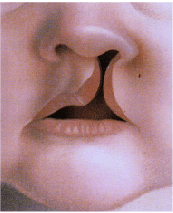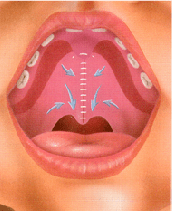Nasal Reconstruction/Cleft Lip, Palate, Nose
Spreader Grafts
Spreader grafts are intended to target a dysfunctional internal vatve and or narrowed or collapsed middle vault. This is most often seen in a patient with a congenital abnormality (crooked nose deformity) or a patient who has undergone elective reductive surgery/rhinoplasty (dorsal hump reduction). The middle vault collapse characteristically presents with a classic cosmetic deformity in which the mid section of the nose is depressed just beyond the nasal bones in the shape of an inverted "v" pattern, also known as the inverted "v" deformity. This appearance is worsened on inhaling through the nose.
Additionally, many patients without prior surgery can benefit from spreader grafts as well; for example, a patient with weak or flaccid upper lateral cartilage that collapses on inspiration or the patient that develops nasal obstruction due to the natural aging process. Spreader grafts can be used uniaterally or bilaterally. FoloWng an exam and medical history, together Dr. Spineli and his patients can design a surgical plan which ad&esses both aesthetics and function.
Nose: Revisions
In an era when plastic surgery is readiy available many patients have had previous rhinoplasty frid themselves with a nasal appearance they frid unacceptable. These patients have had at least one and usually more previous nasal procedures. Many of these patients have had their nasal septum, ear cartiage and other potential donor sites sacrificed by their original surgeon or surgeons. An unsuccessful nasal surgery can result in many of the same functional and cosmetic deformities as seen after trauma, including both aesthetic and functional deformities to the nasal tip. Reconstructive rhinoplasty in these cases requires restoring normal anatomy and appearance in order to address some of the classic sequelae of primary nasal surgery with poor results. including: the pinched nasal tip, internal nasal vatve collapse with the inverted "V" deformity, the "polly beak" deformity and foreshortened nose. among others. Some of these "ible deformities are associated with profound breathing problems. In most cases, Dr. Spin eli addresses both the cosmetic and functional issues concomitantb,', with a combination of cartilage grafts harvested from inconspicuous sites on your own body along other techniques.
Following a thorough and interactive consultation and examination with Dr. Spinelli nasal problems can be addressed in a single ambulatory procedure to achieve a cosmetically pleasing and functional nose.
Cleft Lip and Palate
Cleft lip and palate is a congenital deformity with functional as well as aesthetic implications. It is sometimes inherited but usually a random event which occurs in utero. It occurs in approximately 1 out of every 800 live births and has an ethnic predilection. Clefts are fissures or gaps which are produced by non-fusion of the body's natural structures. Clefts may involve only the lip or palate or include some combination of lip, palate, gums, and nose. Babies born with this condition are candidates for surgery beginning at about 3 months of age on. Depending on the extent of the abnormality staged repairs are performed subsequently.
Most children with cleft lip and palate have some degree of an associated nose deformity. These are due to an abnormality in the size, position, and orientation of the nasal cartilages. These nasal deformities are repaired by Dr. Spinelli using techniques similar to those used in cosmetic rhinoplasty. However, cartilage grafts and specialized skin lengthening techniques geared to the specific problems inherent in the congenital cleft nose deformity are also employed.
Although, the surgery used to address the cleft lip and palate is usually performed by an experienced plastic surgeon such as Dr. Spinelli, other specialist are usually involved with the patients care. These can include dentists, speech pathologists, otolaryngolists (ENT) and geneticists.

